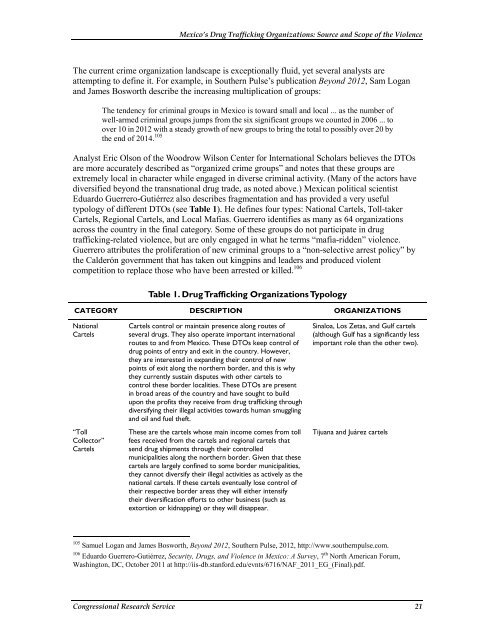Mexico's Drug Trafficking Organizations - Federation of American ...
Mexico's Drug Trafficking Organizations - Federation of American ...
Mexico's Drug Trafficking Organizations - Federation of American ...
Create successful ePaper yourself
Turn your PDF publications into a flip-book with our unique Google optimized e-Paper software.
Mexico’s <strong>Drug</strong> <strong>Trafficking</strong> <strong>Organizations</strong>: Source and Scope <strong>of</strong> the Violence<br />
The current crime organization landscape is exceptionally fluid, yet several analysts are<br />
attempting to define it. For example, in Southern Pulse’s publication Beyond 2012, Sam Logan<br />
and James Bosworth describe the increasing multiplication <strong>of</strong> groups:<br />
The tendency for criminal groups in Mexico is toward small and local ... as the number <strong>of</strong><br />
well-armed criminal groups jumps from the six significant groups we counted in 2006 ... to<br />
over 10 in 2012 with a steady growth <strong>of</strong> new groups to bring the total to possibly over 20 by<br />
the end <strong>of</strong> 2014. 105<br />
Analyst Eric Olson <strong>of</strong> the Woodrow Wilson Center for International Scholars believes the DTOs<br />
are more accurately described as “organized crime groups” and notes that these groups are<br />
extremely local in character while engaged in diverse criminal activity. (Many <strong>of</strong> the actors have<br />
diversified beyond the transnational drug trade, as noted above.) Mexican political scientist<br />
Eduardo Guerrero-Gutiérrez also describes fragmentation and has provided a very useful<br />
typology <strong>of</strong> different DTOs (see Table 1). He defines four types: National Cartels, Toll-taker<br />
Cartels, Regional Cartels, and Local Mafias. Guerrero identifies as many as 64 organizations<br />
across the country in the final category. Some <strong>of</strong> these groups do not participate in drug<br />
trafficking-related violence, but are only engaged in what he terms “mafia-ridden” violence.<br />
Guerrero attributes the proliferation <strong>of</strong> new criminal groups to a “non-selective arrest policy” by<br />
the Calderón government that has taken out kingpins and leaders and produced violent<br />
competition to replace those who have been arrested or killed. 106<br />
Table 1. <strong>Drug</strong> <strong>Trafficking</strong> <strong>Organizations</strong> Typology<br />
CATEGORY DESCRIPTION ORGANIZATIONS<br />
National<br />
Cartels<br />
“Toll<br />
Collector”<br />
Cartels<br />
Cartels control or maintain presence along routes <strong>of</strong><br />
several drugs. They also operate important international<br />
routes to and from Mexico. These DTOs keep control <strong>of</strong><br />
drug points <strong>of</strong> entry and exit in the country. However,<br />
they are interested in expanding their control <strong>of</strong> new<br />
points <strong>of</strong> exit along the northern border, and this is why<br />
they currently sustain disputes with other cartels to<br />
control these border localities. These DTOs are present<br />
in broad areas <strong>of</strong> the country and have sought to build<br />
upon the pr<strong>of</strong>its they receive from drug trafficking through<br />
diversifying their illegal activities towards human smuggling<br />
and oil and fuel theft.<br />
These are the cartels whose main income comes from toll<br />
fees received from the cartels and regional cartels that<br />
send drug shipments through their controlled<br />
municipalities along the northern border. Given that these<br />
cartels are largely confined to some border municipalities,<br />
they cannot diversify their illegal activities as actively as the<br />
national cartels. If these cartels eventually lose control <strong>of</strong><br />
their respective border areas they will either intensify<br />
their diversification efforts to other business (such as<br />
extortion or kidnapping) or they will disappear.<br />
Sinaloa, Los Zetas, and Gulf cartels<br />
(although Gulf has a significantly less<br />
important role than the other two).<br />
Tijuana and Juárez cartels<br />
105 Samuel Logan and James Bosworth, Beyond 2012, Southern Pulse, 2012, http://www.southernpulse.com.<br />
106 Eduardo Guerrero-Gutiérrez, Security, <strong>Drug</strong>s, and Violence in Mexico: A Survey, 7 th North <strong>American</strong> Forum,<br />
Washington, DC, October 2011 at http://iis-db.stanford.edu/evnts/6716/NAF_2011_EG_(Final).pdf.<br />
Congressional Research Service 21















